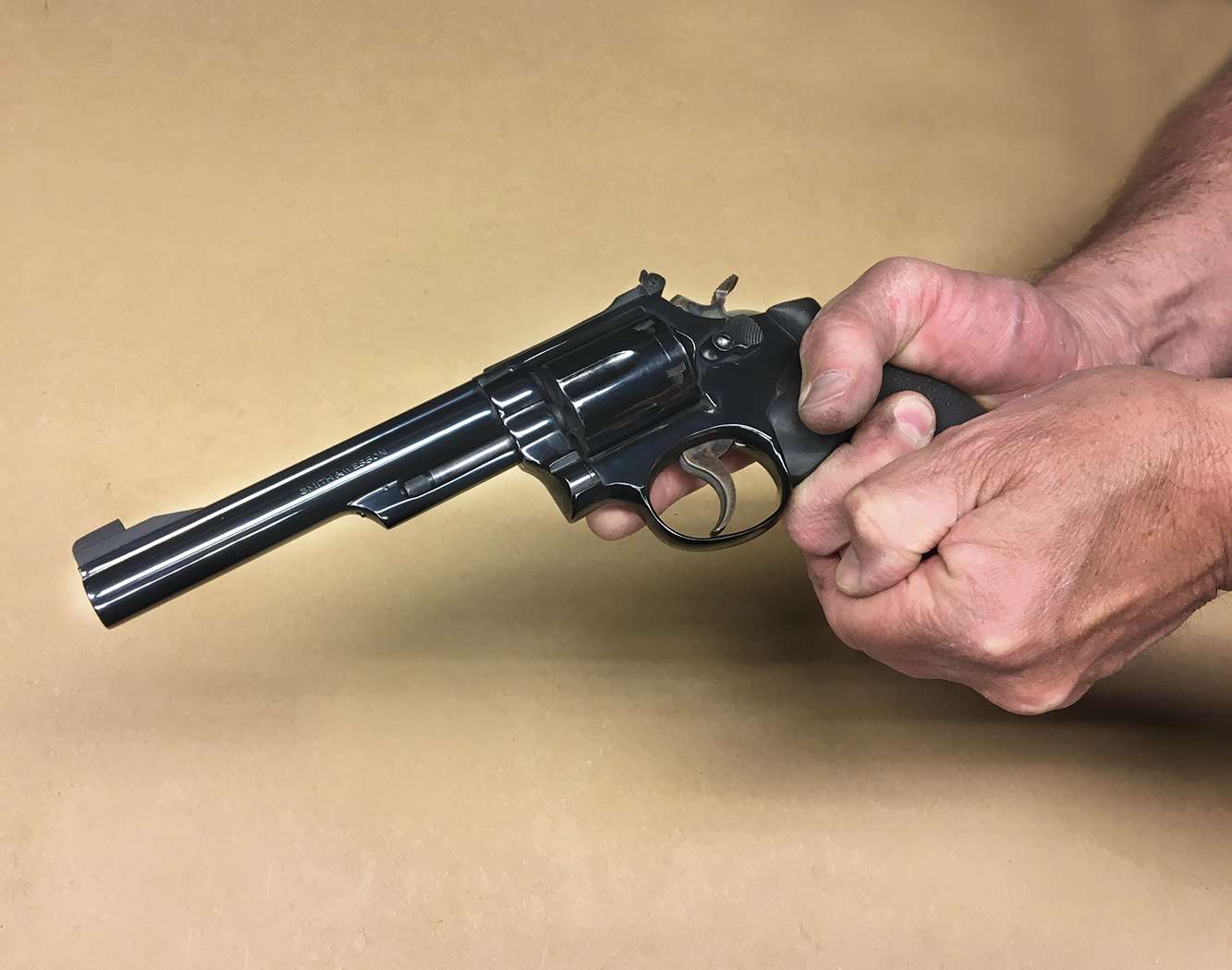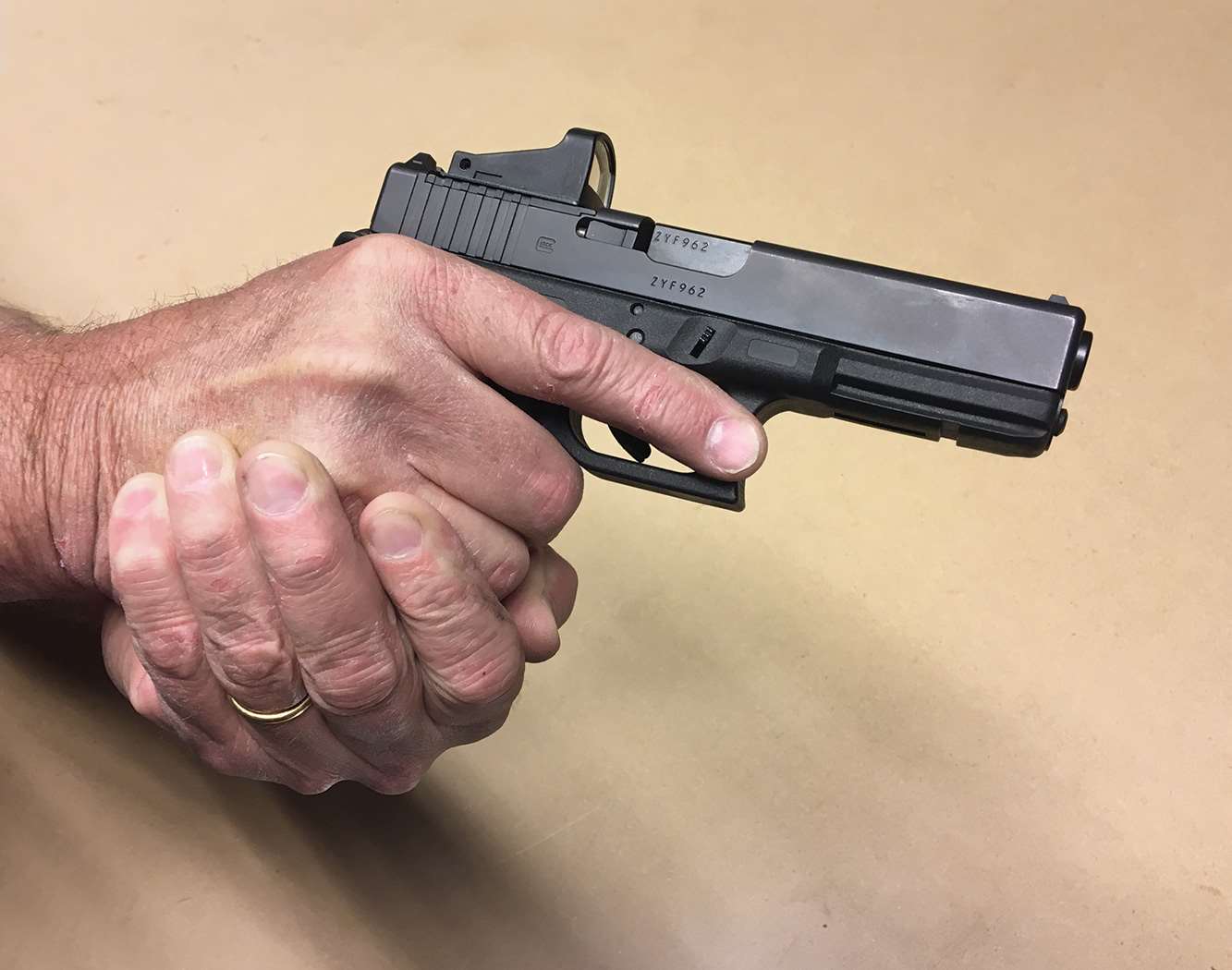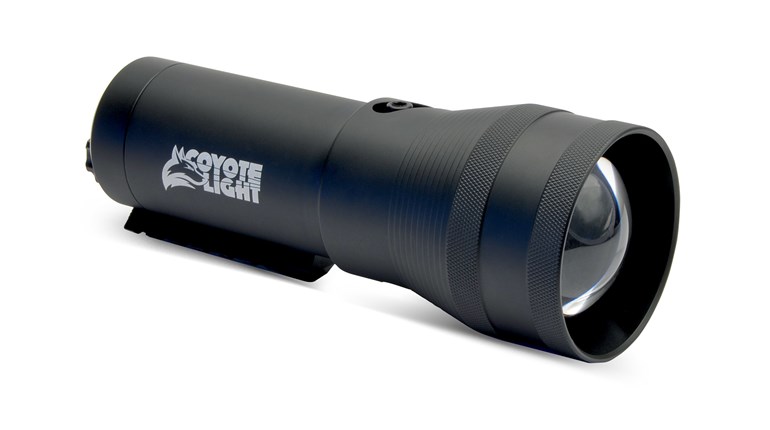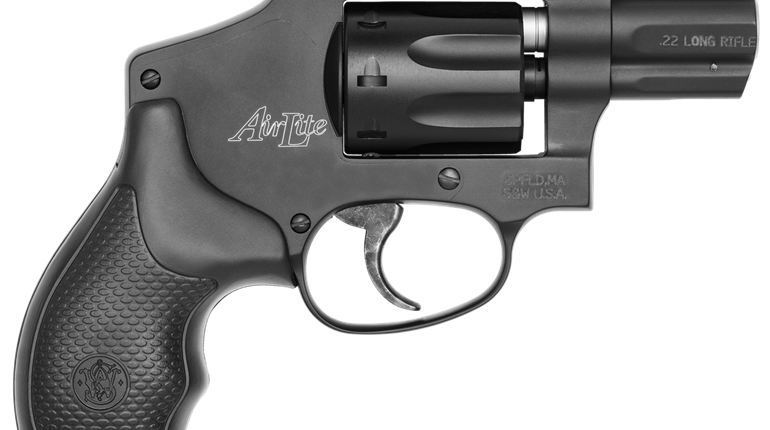
Upon reflection, we’re not sure that full “RANT” mode encompasses our tone for today. In other words, we are really hacked about continuing to see the “teacup” or “cup and saucer” grip method not merely in use, but actually being taught by, er, instructors. Short of the manifestly unsafe, few things in handgun-ology are as pervasively, intransigently stupid as this technique—there using the word “technique” very loosely, we might add.
It’s important to understand, as the Brits would say, what “we’re on about,” so here it is: The “teacup” method has the strong hand presenting the handgun in essentially normal fashion, and we see versions with the elbow locked and unlocked (like it matters). The offense appears mainly with the weak hand sequitur—it is placed under the strong hand, palm up. We expect the original intention was to simulate a “rest” of some sort. There’s a convoluted argument this might even work for single shots, but we find this thoroughly trumped by other body mechanics negatives that accumulate rapidly; more on this shortly.Note that we stopped short of calling this no-doubt beloved “teacher” a pistol quack, however well intentioned. … Oh. Oops.
So against all objections, except perhaps an actual disability that truly makes no other grip possible (and even this is vastly suspect): STOP using this grip; absolutely STOP teaching this grip; and STOP justifying this idiotic mess of a technique because “that’s how _____________ taught me.” (Note that we stopped short of calling this no-doubt beloved “teacher” a pistol quack, however well intentioned. … Oh. Oops.)
And stop immediately, too. In no particular order, here’s why:
Posture Compromise
Only pushing the weak side foot well forward compensates for the poor balance inherent in the ‘cup. While this isn’t a problem in and of itself, it will complicate “getting off the ‘X,’” which is the first thing a Carry Lifer should be thinking about in a defensive encounter unless it’s the ultimate blitzkrieg (in which case, do what you must as soon as you must to survive and protect others). This problem is pronounced if movement to the weak side is needed. Ugh.

For those who are closer to Isosceles in stance, it’s arguably worse. It’s very difficult to execute teacup without the shoulders coming back, creating a “perch” on the hips. This is especially true for shooters with less confidence in their upper body strength. Here read, “You’re now in a rotten position to dissipate recoil energy, up to and including the point where you induce malfunctions in a semi-auto.” Who’d a thunk it? So many flaws, just from grip architecture.
Recoil Management
This may be the worst aspect of teacupping. If the elbow is bent, but muscle tension in the strong arm is high, at least energy will get reflected back into an autoloader in a timely fashion. This likely prevents short-stroking and the associated malfunctions.
But if the elbow is straight, recoil energy will transfer through locked joints all the way to the waist. Combined with a perch, this is almost guaranteed to cause malfunctions, too. We almost spit up lunch when we hear the “grip harder!” recommendation to fix this.
A loose elbow is worst of all: Loose enough, and the firearm can come back far enough in recoil to actually strike the shooter. Don’t laugh. We’ve seen it happen. More than once. To the same shooter. While being “instructed.” In case you’ve missed it, notice too how the weak hand has no identifiable role in attenuating or controlling recoil.
In case you’ve missed it, notice too how the weak hand has no identifiable role in attenuating or controlling recoil. We take the opposite view, in fact: In terms of vectors, the attempt to “rest” the strong hand/arm and firearm actually causes the weak hand to push up, which has the effect of reinforcing upward recoil energy. In all scenarios of tension/joint lock, this means a longer, slower recovery of the sights, and a poor follow-up shot capacity.
Inherently Weak
This is so in two important, disadvantageous ways. First is the right-angled nature of pistol grip and control: The weak side points almost straight up, which is hard to do in the best of circumstances (close to the body). Away from the torso, it’s a bona fide loser. Second, the strong side crosses onto, rather than augments, the weak side, adding the mass of the gun and most of the tissues/bones forward of the elbow. It’s a fatigue and wobble-inducing way to shoot, and in surprisingly short order.
Other Problems

Though it varies from person to person, the all-but-absent ability to control muzzle climb also hides a disproportionate amount of the target from the shooter during recoil and shot recovery. Interestingly, even if a teacupper abandons the grip and substitutes a more positive method (nearly anything is preferable, though we’d recommend the Three Ps), these shooters often retain an extra—and extremely slow—process in prepping follow-up shots. Because their former technique needed an interval to allow their well-traveled sights to “reframe” on the target, then to re-align front-and-rear, and then to point-of-aim, their mental interval for “ready to shoot” is artificially long. It’s anecdotal evidence, we know, but we’ve seen this take a very, very long time—many months of constant work and concentration—to correct/eliminate.
Oddly, the teacup grip seems to reinforce “casting” too. In casting, the firearm is elevated over the intended target (slowly by definition and unsafely if the muzzle moves above the backstop) and then allowed to “settle” into shooting position. If you think this through, it may not be such a surprise after all: It mimics firearm movement on every other shot but the first. It’s no surprise that the mind struggles for some small consistency in the sloppy waters of the teacupper and subconsciously implements this dubious parody. Watch this closely, and you’ll often see these unfortunates sweep themselves, too: The weak hand gets in a rush to be there for the strong hand to settle onto, and is swept as the pistol comes up. On the trigger too soon under stress? Boom, you just shot yourself. On the trigger too soon under stress? Boom, you just shot yourself.
This last business is where we’ll end the madness: The teacupper is doomed to a whole series of small inconsistencies in virtually every shot. The many structural flaws of the method rapidly coalesce with fatigue, head position, relative strength of the arms, handgun grip style and relative recoil (between calibers and action types) to exaggerate seemingly minor variations into poor shots and serious malfunctions. Added to the stress of defensive situations and perhaps of defensive shooting, they become a formula for nearly everything a Carry Lifer has a moral and legal obligation to avoid.
If you’re a teacupper, we certainly have pity, but also little patience. Dump that turkey of a technique post haste, and then Carry on.
<<Toggling “RANT” mode off>>
Frank Winn has been studying arms and their relationship to tyranny, meaningful liberty and personal security all his adult life. He has been a firearms safety/shooting instructor for more than 20 years, and earned state, regional and national titles in several competitive disciplines.


































